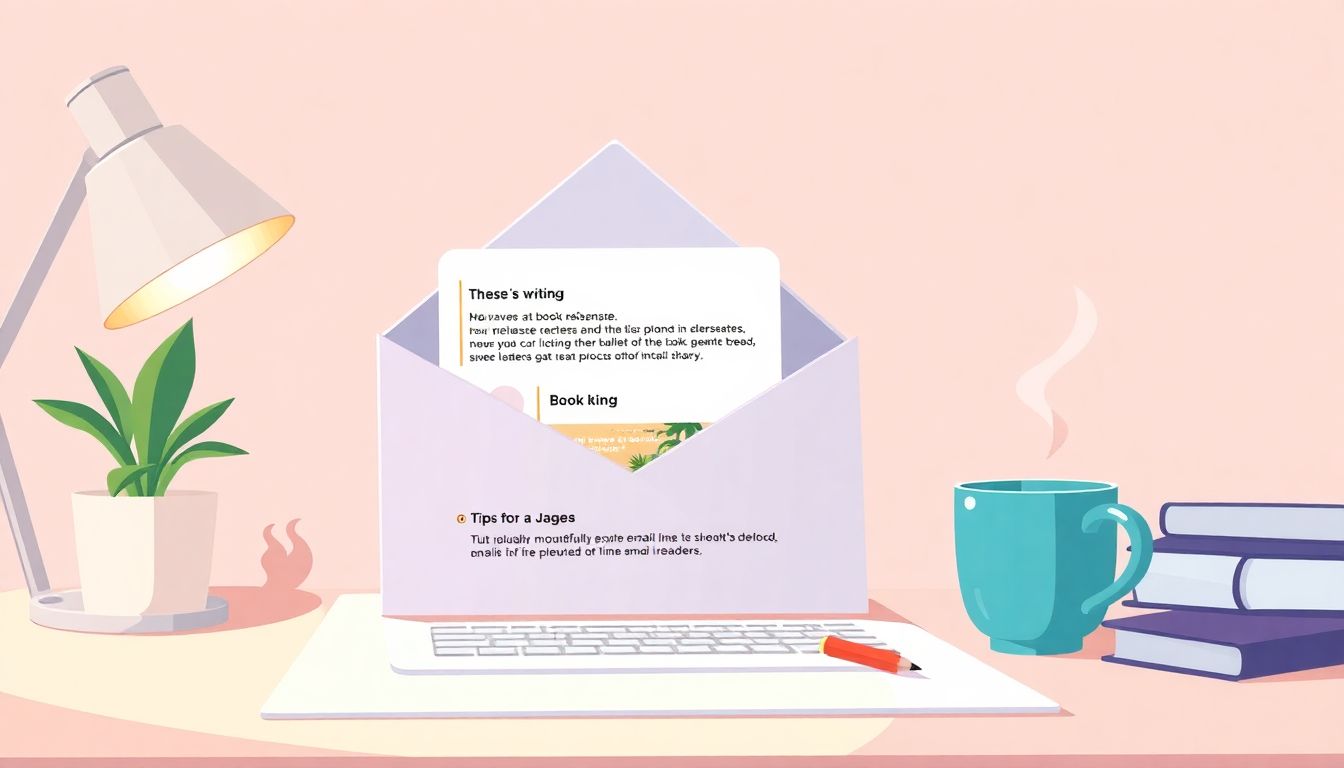Struggling to write email sequences that actually get results? You’re not alone—many authors find their emails end up in inbox purgatory or get ignored. The good news is, with a simple step-by-step plan, you can turn your emails into a their attention magnet.
Keep reading, and you’ll discover how to craft emails that connect, engage, and motivate readers to take action. I’ll share easy tips to help you set up a sequence that feels natural and works like a charm.
Soon, you’ll have a clear path to creating email sequences that make your readers look forward to hearing from you—no more guessing, just results.
Key Takeaways
Key Takeaways
- Create a simple email plan that guides readers from introduction to action, sharing useful content and behind-the-scenes stories.
- Start with a strong welcome email, then send helpful stories, tips, or freebies to keep readers interested, ending with clear calls to action.
- Send emails regularly and at right times to build trust and avoid overwhelming your audience, boosting engagement.
- Use email to stay in touch longer and more consistently than social media, with high return on your investment.
- Gather email addresses ethically, segment your list by interests or actions, and personalize messages to increase open and click rates.
- Create compelling subject lines that catch attention and use personalization to boost open rates.
- Write emails that feel personal by using names and referencing previous interactions, making readers more likely to connect with you.
- Offer valuable content in each email—tips, freebies, or updates—to keep subscribers engaged and interested in your books.
- Include clear, straightforward calls-to-action—like pre-order or download buttons—that tell readers what to do next.
- Regularly test different email elements and analyze results to improve open rates, clicks, and overall effectiveness.
- Set up automatic email sequences based on subscriber actions, saving time and ensuring timely follow-ups to boost sales.
- Track how your emails lead to book sales and reviews, and encourage subscribers to share your emails to grow your audience over time.

How to Create an Effective Email Sequence for Authors
Developing a solid email sequence starts with understanding what your readers want to hear at each stage of their journey. The goal is to guide them from awareness to engagement and, ultimately, to purchasing or reviewing your book.
Begin by mapping out a series of emails that introduce yourself, share behind-the-scenes insights, and provide value—like writing tips or exclusive content. Keep your messages friendly, clear, and personalized to build trust and keep readers interested.
Key Components of an Email Sequence for Authors
An effective email sequence has a few essential parts: a compelling welcome email, engaging content emails, and strategic calls-to-action. Your welcome email should thank new subscribers and set expectations about what’s coming next.
Follow up with a mix of helpful stories, insights about your writing process, or freebies like sample chapters to keep readers hooked. End each email with a clear next step—whether it’s visiting your website, downloading a freebie, or purchasing your book—to move your readers closer to your goal.
Why Consistency and Timing Matter
Sending emails regularly and at the right times helps keep your audience engaged without overwhelming them. A good rule of thumb is to space out your sequences over a few weeks, depending on your campaign’s goal.
For example, an author launching a new book might send an introductory email, followed by a series of reminder and review requests a week apart. Staying consistent makes your readers feel like they’re part of your writing journey, increasing the chances they’ll respond and take action.

Understanding the Power of Email in Book Marketing
Even as social media and other channels grow, email remains one of the most reliable ways to reach your audience.
With nearly 4.5 billion people expected to use email in 2025, it’s clear that your readers are online and accessible through their inboxes.
Unlike fleeting social media posts, emails stay in your subscribers’ inboxes, giving you multiple chances to connect without competing for attention.
Plus, email marketing offers a high return on investment—marketers see an average of $18 for every dollar spent—which makes building a strong list worth your time.
This is why developing strategic email sequences tailored to your readers’ journey can give you a serious edge in selling your books.
Gathering and Segmenting Your Email List
The first step to a successful email campaign is collecting emails ethically—use your website, social media, and freebies to encourage sign-ups.
Once you have a list, segment your subscribers based on their interests, behaviors, or where they are in the reader’s journey.
For example, send a different message to someone who just signed up versus someone who bought your last book.
This personalization increases open rates and click-throughs because your emails feel relevant and speak directly to each reader.
Tools like Mailchimp or ConvertKit can help you automate segmentation and send targeted campaigns with minimal hassle.
Crafting Engaging Subject Lines That Get Opened
Your subject line is the gatekeeper—if it doesn’t catch the eye, your email might never be read.
Keep it short, clear, and enticing; for example, “A Sneak Peek of My Upcoming Novel” or “Your Exclusive Author Tips Inside.”
Test different types of subject lines, like questions, humor, or urgency, to see what resonates most with your audience.
Using personalization tokens—for example, including their name—can also boost open rates, as it makes your email feel more direct and less generic.
Remember, honesty is key—avoid clickbait, and ensure your subject matches the email content to build trust over time.
Personalizing Content to Build Trust and Loyalty
No one likes reading generic messages—they want to feel like you’re writing just for them.
Use their name, acknowledge their interests, and mention previous interactions, like “Thanks for downloading my sample chapter!”
Share stories about your writing process, struggles, or behind-the-scenes moments that make you relatable.
When appropriate, include personalized book recommendations or freebies that match their preferences.
This personal touch encourages readers to open your emails more often and builds a closer connection that can translate into reviews or future sales.
Creating Valuable Content That Keeps Subscribers Engaged
Every email should offer something your readers find useful—be it writing tips, free chapters, or exclusive updates.
Mix educational content with personal stories to keep things fresh and relatable.
Example: Share a quick writing tip based on what you’re working on now, followed by a link to your latest book or a freebie.
Including multimedia like images, GIFs, or short videos can also make your emails more engaging.
The goal is to stay memorable, so think about what your readers want and how you can deliver it naturally.
Strategic Calls-to-Action That Drive Results
Don’t leave your subscribers guessing about what to do next. Be clear with your calls-to-action (CTAs).
Whether it’s “Download your free chapter,” “Pre-order my new release,” or “Leave a review,” make it obvious and compelling.
Limit yourself to one primary CTA per email so your readers aren’t overwhelmed.
Use buttons and bold text to highlight your CTAs and make them easy to find on mobile devices.
Remember, the key is to guide your readers gently but firmly toward the next step in their journey with you.
Testing and Analyzing Your Email Campaigns
Always test different elements—subject lines, send times, content formats—to see what works best for your audience.
A/B testing different subject lines or CTA placements helps you optimize open and click-through rates over time.
Use the analytics provided by your email platform to track metrics like open, click, unsubscribe, and bounce rates.
Watch honestly—if your open rates hover around 20%, you’re doing decent; aim for higher engagement through tweaks and improvements.
Understanding these numbers will tell you what types of content your audience prefers, so you can keep refining your approach.
Automating Your Email Sequences for Efficiency
Set up automation workflows to send emails based on subscriber actions—like signing up, downloading content, or abandoning a shopping cart.
This ensures timely follow-ups without manual effort, letting you focus on your writing while your emails work in the background.
For instance, you might create a sequence that welcomes new subscribers, then gently nudges them to buy your book or join your mailing list for updates.
Automation tools like MailerLite or ActiveCampaign make it easy to design these sequences with simple drag-and-drop builders.
Over time, analyzing automation performance will help you adjust your messages for better engagement and sales.
Measuring Your Return on Investment and Growing Your Audience
Keep track of how your email efforts translate into book sales, reviews, and sign-ups.
Using tracking links and conversion metrics shows you which messages are making an impact.
Remember, building a large email list takes time, but a growing subscriber base means more potential readers.
Encourage your subscribers to share your emails or refer friends—word of mouth still works like a charm.
Lastly, consider offering periodic incentives—like free short stories or discounts—to keep your audience excited and engaged for the long haul.
FAQs
Begin by defining your goals, identify your audience, and map out the sequence flow. Craft personalized messages for each stage, ensuring your emails are engaging and provide value to your readers throughout the journey.
Focus on clear, concise messaging with strong calls-to-action. Segment your audience to send relevant content and use storytelling techniques to keep readers engaged throughout the sequence.
Track key metrics such as open rates, click-through rates, conversions, and unsubscribe rates. Analyzing these helps determine what resonates and where improvements are needed in your sequences.
Send emails at a regular, sustainable pace. Typically, a weekly or bi-weekly sequence maintains engagement without overwhelming your readers, allowing time for your content to resonate.
